Very interesting topic, regards for posting.

Welcome
It's a tradition to watch college football on Saturdays in the Autumn. My goal is to eventually see every Football Bowl Subdivision (FBS) team play in person. I've seen 130 FBS teams play, and visited 128 stadiums across the country. Currently, there are 133 FBS teams.
Thank you for visiting the website
See you at the Big Game!!!
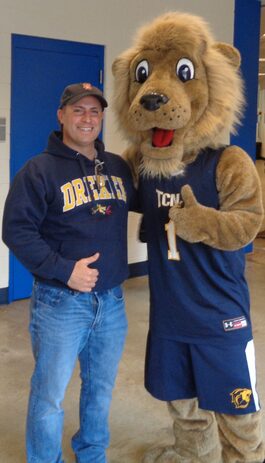
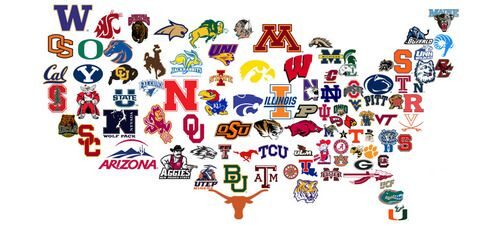
2023 Big Game Saturday Schedule
| Date | Day | The Big Game | Location |
| September 4 | Monday | Clemson at Duke | Durham, NC |
| September 29 | Friday | Columbia at Princeton | Princeton, NJ |
| September 30 | Saturday | Wagner at Rutgers | Piscataway, NJ |
| October 5 | Thursday | Sam Houston State at Liberty | Lynchburg, VA |
| October 7 | Saturday | Texas San Antonio at Temple | Philadelphia, PA |
| October 14 | Saturday | Sacred Heart at Yale | New Haven, CT |
| October 27 | Friday | Brown at Penn | Philadelphia, PA |
| November 18 | Saturday | Marshall at South Alabama | Mobile, AL |
| November 25 | Saturday | Charlotte at South Florida | Tampa Bay, FL |
Big Game Saturday Rankings
Deprived Group of Five
Top 5
1 Liberty (C-USA)
2 SMU (American)
3 Tulane (American)
4 James Madison (Sun Belt)
5 UNLV (Mountain West)
The Group of Five refers to 5 conferences within the Football Bowl Subdivision (American Athletic, C-USA, MAC, Mountain West, Sun Belt, and some Independents). The winner of the Group of 5 receives the Skunk Trophy, because they always get skunked (snubbed/overlooked) by the College Football Playoff Committee (with the exception of *Cincinnati in 2021). *Cincinnati has since been promoted to the Big 12, which is a Power Five Conference.

Keep it up Bid Dawg!
What a great website! Well done, entertaining and informative!
Great stuff. Roll Tide!
Love your website and predictions which add to the excitement of college football
Great suff!
Love your site. It's entertaining and super informative!
Witty commentary and great reminder that college football is so much more than a game.
Great web site enjoy reading your comments
BIG NEWS - Conference Shuffle
Big 12 and SEC
The bullish Buffs of Boulder made a bold move back to the Big 12. Colorado is leaving the PAC-12 and will reunite with some of their old Big 12 friends in 2024. The Arizona Wildcats, Arizona State Sun Devils, and Utah Utes of the four corners region of the Southwest will also be joining the Big 12 Conference in 2024.
The Texas Long Horns and Oklahoma Sooners will be leaving the Big 12 Conference. The two teams are saddling up their horses and ready to ride towards the greener pastures of the South Eastern Conference (SEC). The move will reunite Texas with their longtime rival, Texas A&M, and expand the SEC's regional footprint. This bold powerplay by the two powerhouse programs triggered the Big 12 to replenish their league with: Cincinnati, Central Florida and Houston from the American Athletic Conference, Brigham Young, Arizona, Arizona State, Colorado, and Utah.
PAC-12 and Big Ten
Just when you thought conference realignment couldn't get any crazier, players and fans of sunny Southern California and UCLA will be packing plaid parkas and parting the PAC-12. They will be catching a big wave and hanging ten in the BIG Ten Conference. This move was a Big surprise, given most BIG Ten teams are located in the Midwest. More recently, the Washington Huskies and Oregon Ducks decided to follow the yellow brick road to the Big Ten, as well. Leaving the PAC-12 on life support.
ACC
The Atlantic Coast Conference sprung into action and snagged Southern Methodist from the American Athletic, California and Stanford from the PAC-12. Teams from the eastern seaboard will be riding the Atlantic-Pacific express to the west.
Mind Blown!

Group of Five
In response to the Big 12 poaching, the American Athletic invited six teams from Conference-USA (C-USA): Alabama-Birmingham, Charlotte, Florida Atlantic, North Texas, Rice, and Texas-San Antonio. The Sun Belt was proactive and took three more teams from C-USA: Marshall, Southern Miss, Old Dominion, plus James Madison of the Colonial Athletic Association. Leaving C-USA with only five unclaimed teams: Florida International, Texas-El Paso, Middle Tennessee, Western Kentucky and Louisiana Tech. To survive as a league, C-USA has invited two independent schools: Liberty and New Mexico State, plus four Football Subdivision Conference schools, Sam Houston State, Jacksonville State, Kennesaw State and Delaware to join as conference members.
Stay tuned for more conference realignment!
The Future of College Football
2323 was a great year for college football. The North thrived from yet another climate change. The average daily temperature was a pleasant seventy five degrees Fahrenheit. Recruits flocked to the Northeast for the beautiful weather and revived dormant programs like St. Bonaventure, Buffalo and Providence. Syracuse, West Virginia and Pittsburgh begged and pleaded to rejoin the highly successful Big East Conference, but they were denied. As a result, those schools were downgraded to R2-D2, the equivalent of today’s Division 2. After 300 straight losing seasons, Penn State finally became competitive again once Joe Paterno was reappointed as the head coach. Prior to passing away, Joe was frozen in a carbonite block. Joe’s assistants wheeled his Popsicle shell around the sidelines, while he called the plays by using ESP.
Millions of people flocked away from the Sun Belt States, because of the region’s excessive rainfall amounts. Few recruits were willing to play in the daily downpours that plagued the South since 2171. Most of the schools in the Southeast and Texas downgraded their programs to C-3PO, the equivalent of today’s Division 3. The Big-53 (formally known as the Big-12), ACC, SEC and PAC-Man were forced to dissolve.
The only remaining southern powers were Alabama, Clemson, Florida Gulf Coast, and Old Dominion. Each school built a dome over their campus and competed in the Arena Football League. Their strategy worked. The Crimson Cockatoos, Orange Cats, Doves and Pudding Pops were able to lure blue chip recruits and continued to compete at a high level. Auburn tried to build a dome over their campus, unfortunately their roof crumbled down. Nobody was injured, but Auburn’s campus was totally demolished.

View from a Clemson dorm room, 2323
As a side note, a devastating tsunami hit the great Yellowhammer State in 2159, tidal flooding stretched all the way up to Muscle Shoals. The horrific storm prompted the Alabama Crimson Tide to change their team name. This spurred the “make mascots more peaceful” movement of the 2160s, which compelled other schools to rename their team after nonviolent figures.
On the West Coast, the state of California finally broke off from the continental US and floated into the South Pacific Ocean. Teams like UCLA, Southern Cal, Stanford, Cal, San Diego State and Fresno State had a hard time recruiting because of their remote location. Therefore, many of the Californian teams weren’t very competitive. But, Hawaii and San Jose State became bitter rivals, given their campuses were only 10 nautical miles apart.
In North Dakota, college football boomed, much like their local economy. During the Great Palladium Rush of 2149, fossil fuel was discovered in Fargo. North Dakota became the world’s largest oil supplier, and the price of gas dropped to only $178.95 per gallon. Fargo quickly expanded into the country’s largest city, and North Dakota State University built an enormous stadium capable of holding three hundred thousand fans. Business was so good that Notre Dame, Michigan, Nebraska, Tulsa, Arizona State and Oklahoma relocated their campuses to Fargo. And, Notre Dame changed their name from the Fighting Irish to the Jolly Green Drunks.

Fargo's Skyline, 2323
Ivy League schools reemerged to national dominance, ever since they dropped their academic standards. In 2129, several professors from every Ivy League school tried to clone female gorillas. The experiment backfired and produced millions of annoying “Snookies” (an extinct orange creature that once inhabited the Jersey Shore). The horrible mishap disaccredited all the Ivy League schools. Their institutions regressed to Community College status. Harvard took advantage of the situation and recruited corrupt players; their team was similar to the 1980’s Miami Hurricanes.
Several universities in the Midwest, Rocky Mountains and Pacific Northwest continued to thrive and new rivalries emerged. Boise Province vs. Idaho International was an intense rivalry game. Idaho seceded from America in 2188, but their institutions still competed in the NERD, the equivalent of today’s NCAA. The grandest Midwestern rivalry game was Wisconsin vs. Marquette; followed by Ohio State vs. Eastern Michigan. Seattle Maritime (formally known as the University of Washington) vs. Montana Bear Research College was a fine rivalry, as was the annual game between Colorado Woodwork College and Oregon Beaver Inspection Institute. Since there was world peace, the military schools disbanded and the Army vs. Navy game was no longer existent.
Amid all the changes, college football still did not adopt a successful playoff system. And, several bowls were struggling to attract fans. The Crater Bowl on Mars didn’t draw a good crowd, mainly because human-alien relations were strained after the Giant Alien Emperor of Pluto used the Statue of Liberty as a suppository. The All-American Bowl in Toronto (America seized Canada in 2176) wasn’t successful either, even though Alaska Tech and Newfoundland State played a topnotch game. The Toilet Bowl was discontinued, because Notre Dame fans didn’t travel well anymore.

Fans from Temple (front row) & Mars (back row) at the inaugural Crater Bowl, 2323
The Atlantis Fish Bowl was played in the newly discovered underwater city of New Orleans, and attracted a sellout crowd of dolphins. As a side effect of North Korea’s secret offshore nuclear bomb testing in 2026, dolphins evolved into a highly intelligent species that could walk and talk. Students within a school of dolphins had higher SAT scores than the average public school student.
The Championship game was played during the Chinese New Year in February, since China owned every stadium in the free galaxy. The game remained a strong part of American culture. As a matter of fact, the Villanova Tame Kittens’ stunning upset victory against the Rice (Beijing campus) Peaceful Pandas received the second highest 4-D television rating of the millennium, just behind the 2148 World Series of Water Polo.
2323 Final Rankings
1) Villanova 15-0
2) Rice (Beijing) 14-1
3) North Dakota State 12-2
4) Harvard Community College 12-2
5) Nova Scotia School of Dolphins 11-3
6) Saskatchewan State 11-3
7) West Chester (Pennsylvania) 12-2
8) La Salle 12-2
9) Delaware Tech 10-4
10) Clemson 11-3
11) Rhode Island 11-3
12) Alabama 10-4
College Football is way better than the NFL
The multi-millionaire professionals of the National Football League (NFL) have superior skills compared to the amateurs playing college football. But what the collegiate kids lack in style, they make up for in heart and spirit. The NFL is a bland corporation obsessed with printing their own money and forcing politics on the public. College football is a youthful playground powered by pride and pageantry.
Tradition - College football is fueled by little quirks and fun rituals, which unify quaint campuses across the country on game day. Tenacious tiger teammates rub a rock and run down a hill as they enter the field before kickoff at Clemson. A giant buffalo tracks across the field in Boulder. A wagon pulled by ponies dashes around the end zone after an Oklahoma score. A real eagle soars around Auburn, and a flamboyant falcon flies over the Air Force Academy. The Ohio State marching band dots the “i” during its script Ohio formation. Boise’s field is blue and Eastern Washington’s turf is red. In Aggie Land, Texas A&M fans link arms and legs and sway in unison. At Penn’s Franklin Field, fans toast the team by throwing actual toast on the field. Quirky college traditions dwarf the No Fun League (NFL).
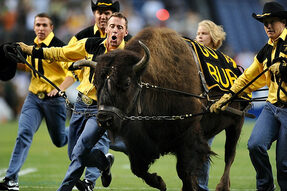
Colorado's Ralphie the Buffalo
Fun Fact - College football began in 1869; the National Football League began 51 years later in 1920. The first Super Bowl was played in 1967, almost one hundred years after the first college game was played.
Marching Bands - Live sounds of instrumental delight greet spectators at college games. Complementing big plays, enlightening halftime, and filling empty voids during the stoppage of play, bands uplift spirits with joyful and jazzy jingles. Games are a musical jubilee. The NFL doesn’t march to the beat of different drummer, because they don’t have marching bands. The dull air above a null NFL facility overflows with angry echoes of annoyed fans yelling aimlessly at overpaid ruffians, noises hardly appetizing to the ear.

Ohio State Marching Band
Fanatical Fans - College fans are young at heart and family oriented. A typical collegiate ballpark boasts a vibrant student section filled with youthful excitement and adrenaline. The student section is a diverse social scene populated with several friendly female fans. Plus, it’s common to see happy families in the general admission section, because many universities offer affordable ticket deals. NFL stadiums are polluted with tons of grumpy old men that regret their life and are trying to get away from their wife. They’re grumpy, because they took out a second mortgage to afford the major league ticket prices.
Every College Game Counts – A short 12-game FBS regular season mixed with only 4 playoff spots means every game has playoff ramifications. If a team loses more than one game, chances of competing for a National Championship are greatly diminished. But even if a team is eliminated from playoff contention, the team continues to play hard for a better bowl berth. During the NFL’s supersizes season, teams can lose 6 or 7 games and still make a playoff run and compete for the Super Bowl. That’s hardly super!
Weather - The college football regular season concludes in late November before the arrival of brutally cold weather. Sure there are a couple chilly games played, but the gales of autumn feel like a tropical breeze compared to the blustery artic winds of January. And most college post-season games are played in cozy domes or warm climates. There’s always a dark cloud on the NFL’s horizon, because their long season lingers into frigid February.
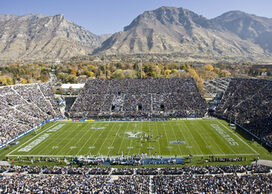
Sun-soaked, beautiful day in Provo
Rivals - College sports claim more rivalry games, boasting bragging rights among neighbors. Rivalries in the NFL just aren’t the same. For example, Dallas vs. Washington is historically the top NFL rivalry game. But DC and Dallas are located roughly 1,350 miles apart, their local fan bases rarely ever interact given the distance. On the other hand, college fan bases almost always overlap because of regional proximity: Alabama vs. Auburn, Ohio State vs. Michigan, Texas vs. Oklahoma, Florida vs. Florida State, Army vs. Navy, Stanford vs. Cal, UCLA vs. USC, Clemson vs. South Carolina, North Carolina vs. Duke, Kentucky vs. Louisville, Washington vs. Washington State, Oregon vs. Oregon State, BYU vs. Utah, Harvard vs. Yale, Lehigh vs. Lafayette, etc. The NFL manufactured rivalries by mandating divisional foes to play each other twice per season. Whereas, Universities let regional rivals blossom naturally.
Television Coverage – Numerous Saturday games are broadcasted on free TV; The SEC on CBS, Notre Dame on NBC, plus 3 to 4 national games on ABC and Fox. Use the trusty television remote to flip between games during commercial breaks. It’s an all-day football feast fit for the hungriest couch potato, a smash-mouth smorgasbord. The NFL has a limited broadcast window. Typically, towns only get 2 to 3 games per Sunday, not much variety.
Better Mascots - Numerous universities have animals prancing and dancing around their sidelines. An adorable Georgia Bulldog keeps cool in an air-conditioned dog house between lush green hedges. A longhorn steer grazes in Austin. South Carolina has a real rooster crowing in the stands, while Temple’s owl hoots in harmony with the fans. Florida State, Southern Cal, Army and Virginia have equestrians riding houseback around the stadium. A real tiger named Mike prowls around LSU. Navy has a goat, UNC has a ram, and Arkansas has a ham. Plus, the plush costume-wearing collegiate mascots interact with the fans. They go into the stands for photo opportunities, and often times, fans can rush the field after a big win to get a quick pic with their furry friends. There are no live animals on the NFL sidelines, it’s illegal for fans to rush a Pro field, and their snotty mascots rarely ever head into the stands to interact with the unappreciated crowd.
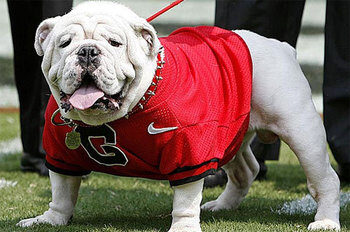
Uga enjoying a dog-gone good view of the game
NFL players are bigger. But bigger isn’t always better. Overgrown Pro players never engage in an entertaining triple-option formation and captivating trick plays, because offensive players would get maliciously mangled by massive defensive thugs. In college football, the play book is wide open, anything can happen, and trick plays are more common given the smaller players. Amateur football is unpredictable, exciting, and therefore better!
Mickey Mouse is killing College Football
The magical mouse of Disney World portrays an image of bright, whimsical delight. But don’t be fooled by the light-hearted sight of the round-eared socialite, for the devious rodent is covering up a much darker plight.
The Walt Disney Company owns the American Broadcast Network (ABC) as well as the Entertainment and Sports Programming Network (ESPN). Disney is a multi-billion dollar corporation. ESPN and ABC are merely puppets in Disney’s extremely profitable play.
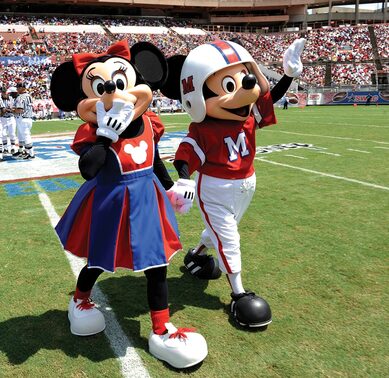
ESPN broadcasts more college football games than any other network and monopolizes the postseason. 37 of the 41 bowls aired on ESPN-affiliated channels. The College Football Playoff and signature bowl games like: the Rose, Sugar, Orange, Cotton, Fiesta and Peach are only available in households that pay for cable television. The bunny-ear antennas that once sat atop the tube to gather free TV have been replaced by greedy mouse-ears charging outrageously high monetary fees.
The Playoff has been losing viewers since its advent. ESPN’s inaugural TV ratings in January 2015 garnered 33.4 million people, whereas the Playoff in January 2017 only attracted 19.8 million people, according to the Nielsen Ratings. As more Americans cut the cord and cancel their cable service, the bright spotlight of college football’s grandest spectacle continues to dim. The rich executives at Disney need to loosen their strangle hold on the sport and give more fans an opportunity to see the Playoffs on free TV. Ratings will skyrocket by screening games over the air on ABC, and Disney will still make a killing on profitable commercial advertisements. As a side note, the National Championship game should have an earlier kickoff time, 8:00 PM Eastern Time on a weeknight is too late to start a four-hour game.
Speaking of commercials, football is getting dragged through the dirt by endless TV timeouts. In an era of shorter attention spans, it’s imperative to minimize the broadcast time of sporting events. Every network tries to stretch out their programming, but Disney makes Stretch Armstrong look inflexible. For example - On November 12th, 2016, three games kicked off at 3:30 on the three national networks; Army played Notre Dame on NBC, Auburn played Georgia on CBS, while Clemson played Pitt on ABC. NBC’s game took 3 hours and 10 minutes to complete. CBS’ game took 3 hours and 23 minutes to play. Disney’s gem took a whopping 4 hours and 2 minutes to finish four quarters. Hopefully the fans at Clemson sneaked a sandwich into the stands, because four hours is a long time to be stuck sitting on uncomfortable metal bleachers without a snack. Furthermore, every eight o’clock Saturday night game on ABC seems to last until midnight Eastern Time.
More is less when factoring supply and demand. Disney should speed up the game by airing less commercial breaks, counteractively charging more for the limited advertising slots. Shorter game times would increase interest as viewers would be more inclined to watch an entire event instead of just catching bits and pieces.
Mickey Mouse’s bleak, high-pitched, squeak needs a tweak. Instead of hiding games on cable TV, Disney needs to act as an ambassador and reach out to a larger audience. They need to broadcast more games on ABC with fewer commercial breaks. Otherwise, Mickey is just acting Goofy.
Gangs of New York fight for Media Rights
New York is well known for greasy gyros in buns, witty Jerry Seinfeld reruns, inappropriate Anthony Weiner tweets, and tasty Nathan’s hotdog meats. The smoggy City that suffers from insomnia (aka the City that Never Sleeps) also stakes claim to the Statue of Liberty and Giants football, even though Lady Liberty and her giant entourage reside in North Jersey. But one thing native New Yorkers rarely boast about is college football. NYC doesn’t have a FBS team, and for good reason, the majority of sports fans in the Big Apple prefer watching professional games. So, why are the ACC and Big Ten feebly force feeding gridiron greed on Gotham?
The prestigious fraternity of plush ACC mascots feverishly welcomed Syracuse, Pittsburgh and Notre Dame to the conference by opening the NASDAQ stock exchange on July 1, 2013.

Who put the mascots in charge of my 401k?
In a corny publicity stunt, those same mascots ran wild around the five boroughs. The ACC wants to cash in on America’s media capital, and hopes the citrusy Orange of Upstate New York will deliver a loyal contingent among the Empire State’s Lower East Side. The average Joes of Tobacco Row aren’t the only ones trying to get a piece of the Big Apple pie. The Big Ten wants to amass an elite empire following as well. So much so, the Big Ten decided to share their rich cheddar with Rutgers in anticipation of the Scarlet Knights producing a buzz on the flipside of the Hudson.
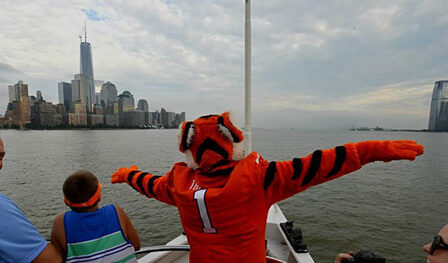
The Hudson skyline looks a lot different than the Clemson Tiger's native Lake Hartwell
What ACC and Big Ten management fail to realize is college football has been dormant in Hymie Town ever since Army football sunk into oblivion in the 1950’s. Yankee Stadium hosts the Pinstripe Bowl, which will coincidently invite teams from the ACC and Big Ten, but this second-tier exhibition will be played in a reduced capacity baseball stadium on a cold winter day. Baseball, cold weather and reduced capacity isn’t a good combination to win over a fickle football fan-base.
Even on an autumn afternoon, when a game is played in a state of the art football facility with a top ranked team present, New Yorkers barely showed support. The second ranked Sothern Cal Trojans played Syracuse at the new Meadowlands Stadium in a game dubbed as “New York’s College Classic” on September 7th, 2012. Not a single spectator was found in the stadium’s massive upper deck. The scoreboard proudly displayed Syracuse’s self proclaimed title of being, “New York’s college team” as USC made orange juice out of the scurvy-ridden ‘Cuse.
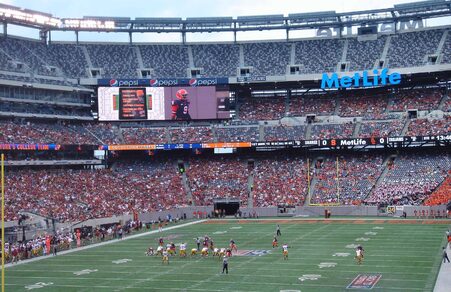
So, where were the metropolitan fans? Either they were swimming with the fishes off the banks of Staten Island or that game demonstrates New York’s invisible love affair with collegiate football. And if Syracuse isn’t NYC’s adopted stepson, the State University of New Jersey surely isn’t either. Despite a recent splash of success, Rutgers athletics has long been a laughing stock. Big Ten management are meatheads for thinking the shady Sicilian Scarlet Knights will dish up an extra large audience in Zoo York. Forget about it! Jersey is the birthplace of college football and Frank Sinatra, so maybe the Big Ten decided to “send in the clowns” when they invited the Scarface Scarlets.
The Northeast has an extremely large population, but density alone doesn’t translate into strong viewership, which is why the old Big East teams couldn’t muster up nearly as much media money as some schools located in the sparsely populated Southeast. This brings up another point; shouldn’t the ACC and Big Ten reward their loyal fans within their preexisting regional footprints rather than cater towards a distant frontier? The mighty SEC doesn’t prance around the crowded streets of Manhattan to attract new groupies. The SEC gained a massive national audience by winning numerous National Championships.
Speaking of expanding regional footprints, does the Big Ten brass really think fans from the wholesome cornfields of Nebraska will embrace a trip to polluted Piscataway? Does the ACC care about the warm weather fans from sunny South Beach who have to purchase puffy parkas for a vacation to blustery Pittsburgh? Big Ten and ACC are banking on an optimistic prognostication that the Northeast will acquire a stronger taste for college football. But, it’s difficult to predict future sporting trends. Past add-wizards forecasted a huge spike in fútbo viewership, yet very few Americans currently watch Monday Night Soccer.
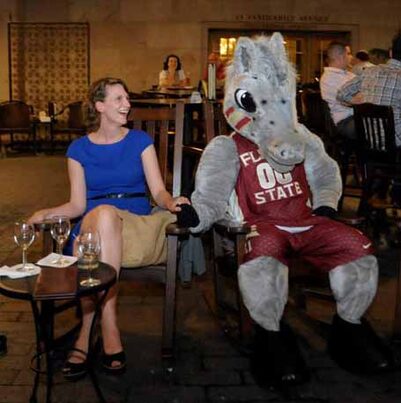
Breakfast at Tiffany's, don't mess with the ACC or you'll find a horse's head in your bed… just ask the American Athletic Conference
The ACC didn’t learn from their experimental acquisition of Boston College in 2005. Rather than tapping a robust northern market, the ACC found out the hard way that college ball doesn’t mix well with clam chowder and creamed filled donuts in Bean Town. It sits fifth fiddle behind the Sox, Pats, Celtics and Bruins. Similar to their Massachusetts neighbors, New Yorkers will not wholeheartedly warm up to amateur pigskin games.
On the bright side, New York City has a healthy addiction to college hoops, and ACC basketball will be bigger and better than ever. Maybe the ACC commissioner wants to march his brilliant dog and pony show into the World's most famous arena. There's only one problem, the new Big East conference retains the sole right to play their conference tournament at Madison Square Garden. The Big East has squatter rights to the Big Apple's main stage. Therefore fans of Carolina, Duke and Syracuse will be staring down blinking neon no-vacancy signs all across Time Square for the foreseeable future.
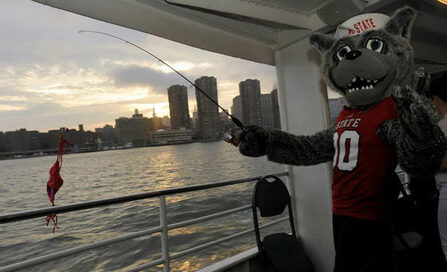
Don't eat that fish!
An affluent ACC and a wealthy Big Ten have begun their quest to tame the prosperous media beast of the East. Will those greedy gangs make a big bang, or will they water down their brand in the process? Only time will tell. But one thing is for sure - They must produce a readily available, highly competitive and extremely exciting sports product to attract New York’s attention, or else the City that Never Sleeps will opt to snooze through yet another shoddy off-Broadway amateur act in a New York minute.
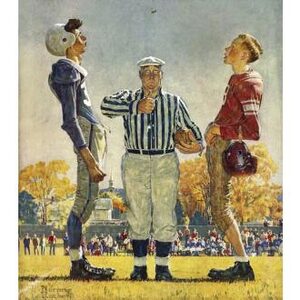
There's nothing better than watching
college football on a crisp autumn afternoon
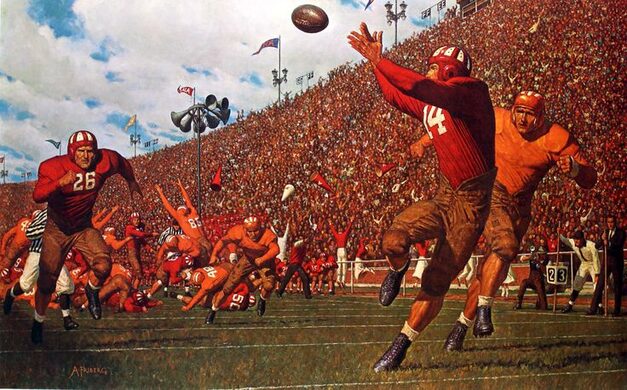
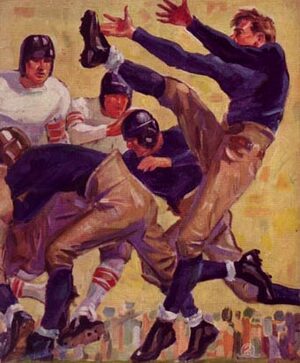



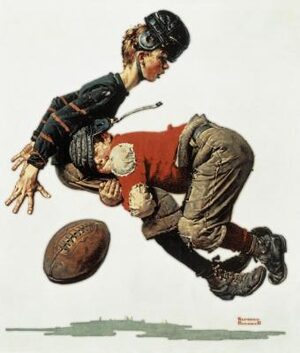
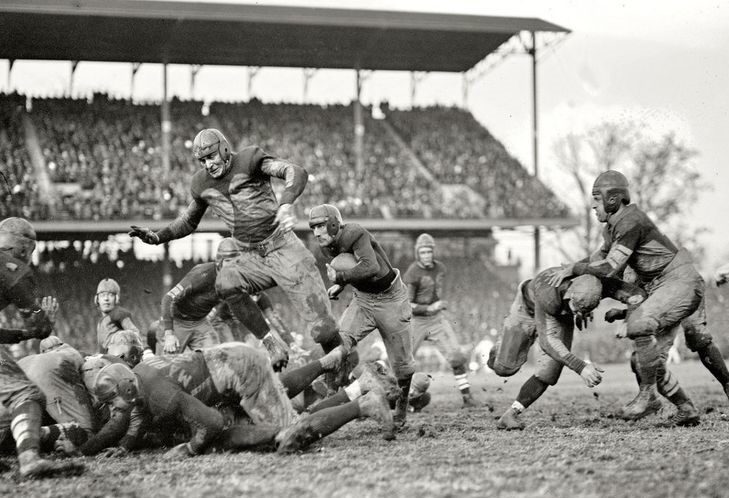
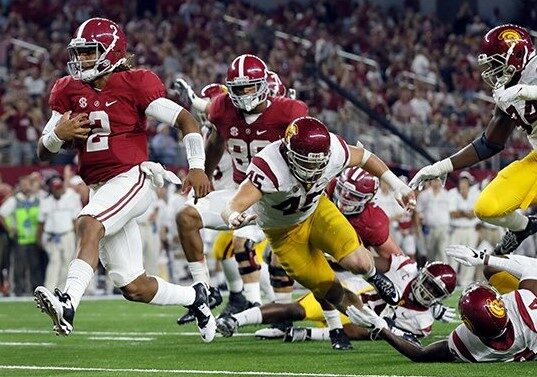
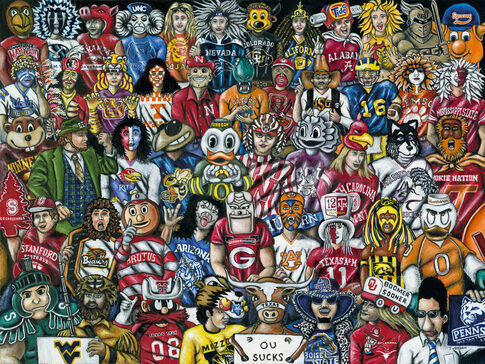
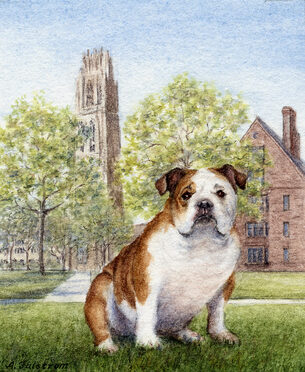 Yale Bulldogs once dominated college football
Yale Bulldogs once dominated college football
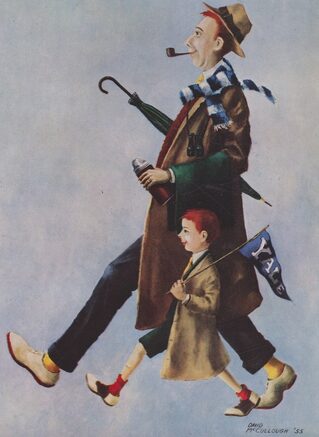
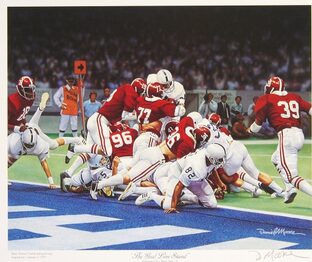
Goal Line Stand
January 1st, 1979 Sugar Bowl
Alabama 14, Penn State 7
Some teams traveled by train in the old days
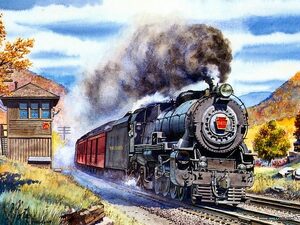
On November 7th, 1896, Auburn students greased the train tracks around their local
station. When Georgia Tech's train arrived for the game, it was unable to stop on the slick tracks and skidded five miles past the train station. The Yellow Jackets had to walk back to town for the game and fell to Auburn by a score of 45-0
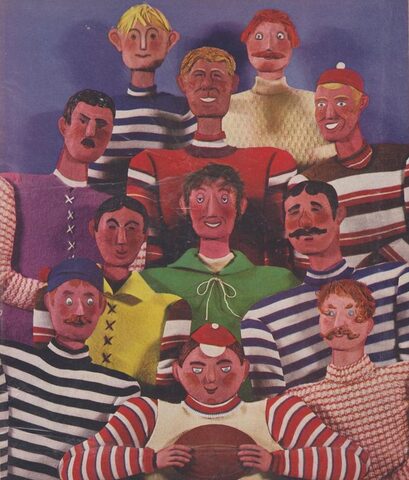
One of the Best Teams Ever
In 1899, the Sewanee Tigers football team won all 12 of their games. Five of those wins, all shutouts, came in a six-day period while on a 2,500-mile train trip against: Texas, Texas A&M, Tulane, LSU and Ole Miss.
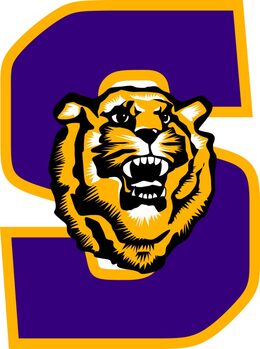
The Play

November 20th, 1982, California ran back a kick in the final seconds of the game for the win, as Stanford's band prematurely took the field in celebration.
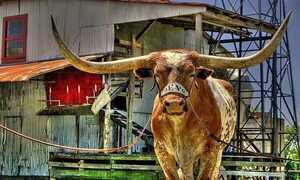
College football reigns supreme in Texas...
and that's no bull!
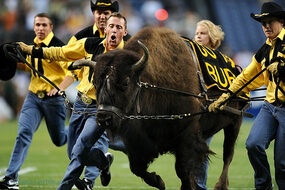
Ralphie the Buffalo of Colorado

Welcome to Aggie Land
Home of the 12th Man
USC cheerleaders are the pride of LA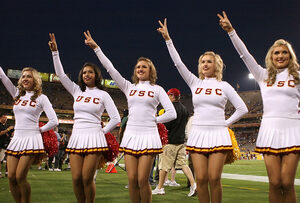
Irish Eyes are smiling in South Bend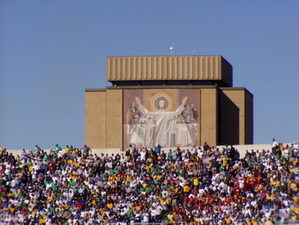
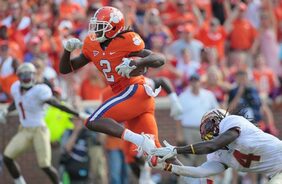 Clemson is the cream of the ACC crop
Clemson is the cream of the ACC crop

Sailing on Lake Washington
before an exciting Huskies game

Script Ohio dotting the 'i'
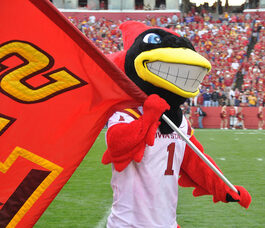
The Iowa State Cyclone is always smiling
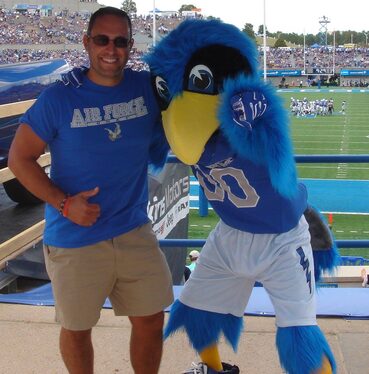
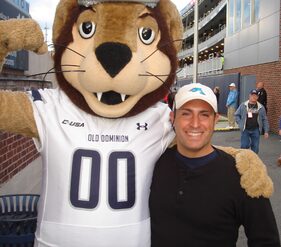

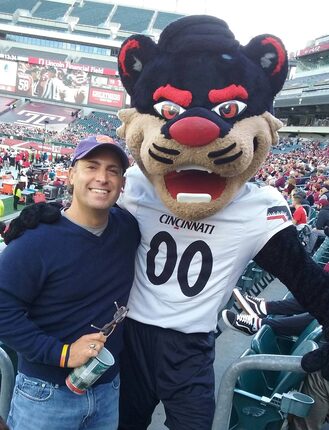

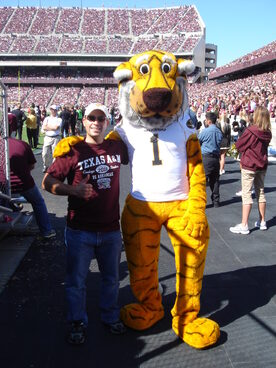
On the road to another great game
Views
291681
FBS Top 25 All-Time Wins
| 1 | Michigan | 989 |
| 2t | Alabama | 953 |
| 2t | Ohio State | 953 |
| 4 | Notre Dame | 938 |
| 5 | Texas | 936 |
| 6 | Oklahoma | 934 |
| 7 | Penn State | 920 |
| 8 | Nebraska | 912 |
| 9 | Georgia | 868 |
| 10t | USC | 867 |
| 10t | Tennessee | 867 |
| 12 | LSU | 833 |
| 13 | Auburn | 793 |
| 14 | Clemson | 789 |
| 15 | West Virginia | 772 |
| 16 | Texas A&M | 771 |
| 17 | Virginia Tech | 765 |
| 18 | Washington | 761 |
| 19 | Pittsburgh | 758 |
| 20 | Florida | 753 |
| 21 | Georgia Tech | 749 |
| 22 | Syracuse | 737 |
| 23 | Arkansas | 736 |
| 24 | Wisconsin | 735 |
| 25 | Navy | 733 |
AP National Championships
| 1 | Alabama | 13 |
| 2 | Notre Dame | 8 |
| 3 | Oklahoma | 7 |
| 4t | Miami (FL) | 5 |
| 4t | Ohio State | 5 |
| 4t | USC | 5 |
| 7t | Nebraska | 4 |
| 7t | Minnesota | 4 |
| 9t | Clemson | 3 |
| 9t | Florida | 3 |
| 9t | Florida State | 3 |
| 9t | Georgia | 3 |
| 9t | LSU | 3 |
| 9t | Texas | 3 |
| 15t | Michigan | 3 |
| 15t | Penn State | 2 |
| 15t | Pittsburgh | 2 |
| 15t | Tennessee | 2 |
| 15t | Auburn | 2 |
| 20t | BYU | 1 |
| 20t | Colorado | 1 |
| 20t | Maryland | 1 |
| 20t | Michigan State | 1 |
| 20t | Syracuse | 1 |
| 20t | TCU | 1 |
| 20t | Texas A&M | 1 |
Best Rivalries
| Army vs. Navy |
| Alabama vs. Auburn |
| Michigan vs. Ohio State |
| Oklahoma vs. Texas |
| Florida vs. Florida State |
| Notre Dame vs. Southern Cal |
| Clemson vs. South Carolina |
| Harvard vs. Yale |
| California vs. Stanford |
| Lafayette vs. Lehigh (oldest college rivalry) |
| Minnesota vs. Wisconsin (oldest FBS rivalry) |
| Southern Cal vs. UCLA |
| Florida vs. Georgia |
| Florida State vs. Miami |
| Alabama vs. Tennessee |
| Florida vs. Tennessee |
| Oregon vs. Oregon State |
| Baylor vs. TCU |
| Arizona vs. Arizona State |
| Washington vs. Washington State |
| Virginia vs. Virginia Tech |
| Indiana vs. Purdue |
| Michigan vs. Michigan State |
| Oklahoma vs. Oklahoma State |
| BYU vs. Utah |
| Georgia vs. Georgia Tech |
| Ole Miss vs. Mississippi State |
| Louisville vs. Kentucky |
| Auburn vs. Georgia |
| Illinois vs. Northwestern |
| Duke vs. North Carolina |
| Kansas vs. Kansas State |
| Iowa vs. Iowa State |
| North Carolina vs. NC State |
| Cincinnati vs. Miami (OH) |
| New Mexico vs. New Mexico State |
| Bowling Green vs. Toledo |
| Akron vs. Kent State |
| Montana vs. Montana State |
| Grambling vs. Southern |
| Louisiana-Lafayette vs. Louisiana-Monroe |
| Florida Atlantic vs. Florida International |
| Randolph-Macon vs. Hampden-Sydney |
| Amherst vs. Williams |
| DePauw vs. Wabash |
Mid-Major Showdown
The dust has settled on the conference realignment carousel for the time being. As a result, the WAC got bushwhacked, Big East football morphed into mid-major melting pot and was renamed the American Athletic Conference, numerous longtime rivalries vanished, and stadium attendance plunged faster than Facebook stock. On the flipside, sport networks like ESPN and the Big Ten channel greatly benefited from the conference shuffle. In turn, those sport networks rewarded several lucky schools with new television contracts worth millions of dollars.
But all is not lost for the lame ducks stuck amuck in a mid-major glut. The Mountain West and American Athletic should take advantage of their mediocre status by having their conference champions meet in a postseason bowl.
Having the Mountain West and American Athletic champions play each other would settle bragging rights as to which conference is the best of the rest, masters of the middle class. Plus, there must be bad blood between the urban city slickers and the rustic mountain folks, given both leagues were in a fierce tug-of-war battle over the beefy blue Broncos of Boise. The best way to settle that animosity is on the gridiron.
There are several prime locations to play the game. The Liberty Bowl once hosted a similar matchup between the Mountain West and Conference USA champions. The historic Cotton Bowl Stadium (not to be confused with Jerry World’s billion dollar palace) is located smack dab in the middle of enemy territory. Or, the game could be rotated between the East Coast (Tampa, Jacksonville or Orlando) and the Western Frontier (Albuquerque, Las Vegas or San Diego).
Winners of the MAC or Sun Belt could form a similar bowl alliance. Currently, the highest rated team from the Group of Five (American, C-USA, Mountain West and Sun Belt) will earn a berth in a major bowl under the new post season model. For example, if Boise State finished the season as the highest ranked non-automatic qualifier team, the Broncos would be bound for a major bowl (Fiesta, Cotton, etc). Therefore, this proposed bowl could feature the second ranked Mountain West team against the best American team. Or the conference champion from C-USA, MAC or Sun Belt could be substituted in for the Mountain West if deemed a better match-up.
There may be some down years for the smaller leagues, which may translate into a poor matchup here or there. But surely, there will be several great years when this mid-major masterpiece trumps many major bowls.
Advent of the Conference Championship
Thousands of enthusiastic spectators annually flock to Atlanta, Georgia to witness the proud pageantry of the South Eastern Conference (SEC) championship game. Historic powerhouses collide in a stunning spectacle to determine the finest college football team in the Southeast. With all the comradery associated with this great gridiron tradition, it's almost impossible to fathom the conference championship game originated from a humble beginning.

SEC always draws a good crowd for their conference championship game
In 1986, the Pennsylvania State Athletics Conference (PSAC) was comprised of 14 Division II institutions. The PSAC was a quintessential geographic association; similar-minded schools located within the friendly confines of the Keystone State. But even though the members were nicely nestled close together, the Western Pennsylvania teams rarely played the Eastern Pennsylvania teams. It was mathematically impossible for all 14 teams to play each other in a 10-week season. Given the schedule limitations, Pennsylvania sportswriters determined the conference champion at the end of the season. But having sportswriters nominate a champion was as subjective as Punxsutawney Phil’s weather prediction on Groundhog Day. A true champion earns its merits on the field.
One morning, the sleepy suburban borough of West Chester awoke to a brilliant idea. The PSAC Commissioner (Todd Eberle) and the Athletic Director of West Chester University (Dick Yoder) proposed the idea of staging a conference championship game. The PSAC would divide into 2 divisions, east and west. And the season would culminate with the divisional winners competing against each other in a conference championship game.
Initially, the PSAC's proposal specified a league must have a minimum of 14 members in order to stage the contest. However the Central Intercollegiate Athletic Association (CIAA) found the PSAC's idea quite intriguing. But, the CIAA only had only 12 members. To accommodate the CIAA, the original plan was tweaked to include conferences with 12 members as well. The PSAC sent their proposal to the National Collegiate Athletic Association (NCAA) for approval.
Because a Division II conference made the pitch, the request fell under the radar with little fanfare. Back then, the proposal didn't affect any of the major college football teams, none of the Division I-A conferences had more than 10 members. Therefore, the proposal passed without a hitch. The conference championship concept was approved by the NCAA in 1987. The PSAC commissioner dubbed the new bylaw as, "the little rule in the back of the rule book." But the new rule was about to have an enormous impact on big time college football.
In 1990, the 10 members of the SEC invited Arkansas and South Carolina to join their fruitful fraternity. Then, the new 12-team SEC used the "little rule" to their advantage and staged a lucrative season finale. The SEC championship game gained momentum over the years. Massive amounts of profit rolled in from the event. As a result, other conferences decided to jump on the prosperous bandwagon. Currently, every FBS conference has a championship game.
The grass is greener in Atlanta. The SEC championship game garners $16 million per year. It’s the Super Bowl of the South! Ironically, the humble origin of the conference championship concept sits hidden in the hills of Pennsylvania. The PSAC championship game fetches a mere $2,000 per year. That’s not even enough money to rent a luxury box suite at the SEC championship game.
Indiana of Pennsylvania beat Shepherd in the 2022 PSAC championship game
Bring in the Billiken
The St. Louis Rams bolted for sunny Southern California, vacating the 66,000-seat capacity Edwards Jones Dome. River City is best known for steamboats sailing on the mighty Mississippi waterway, cardinals shagging flies on bright summer days, and Budweiser Clydesdales parading around the grand archway. Football also reigned supreme, when the Rams were known as the “greatest show on turf.” Rather than cry into a half-empty Bud Light bottle over the Ram’s departure, St. Louis stewards should rekindle some past gridiron glory.
Enter St. Louis University (SLU), a fine Catholic college with an enrollment of 13,505 students and an enormous endowment of 1.027 billion dollars. While SLU doesn’t currently field a football team, the Billikens did play football from 1899 to 1949. They even completed three undefeated seasons during their playing days in 1901, 1904, 1906. The bulky Billikens boasted big bragging rights by throwing the first legal pass in college football history on September 5, 1906, against Carroll College.
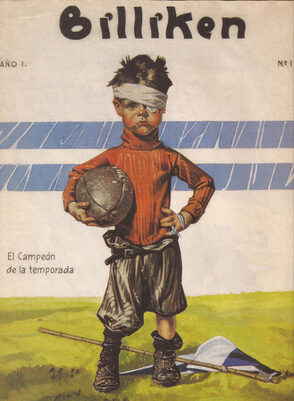
When several major Midwestern schools expanded their stadiums in the late 40’s and early 50’s, SLU was confined to a cramp campus footprint in the city. Their campus didn’t have enough space for a supersized stadium. In turn, the Billikens were unable to compete with their rivals’ ever growing football facilities. SLU opted to drop football as a result. But the Jesuit’s jammed locale is now a blessing. The University is located within two miles of the vacant Edwards Jones Dome. Considering the Dome isn’t a home to anyone anymore, not even a garden gnome, why let it sit alone? Turn on the lights and fill the stands with enthusiastic college fans. Bump up the Billikens!
The Lou is the largest US media market without a Division 1 football team. Start at the Division 1 - Football Championship Subdivision level. The Missouri Valley Conference would be a perfect fit. If SLU is successful on the field and draws in the community, then surely the Mid-American or Conference-USA would promote the brilliant Billikens to rejoice in the profitable Football Bowl Subdivision. The sky is the limit for St. Louie; given a large media market, existing professional practice facilities and stadium. After decades of success, maybe SLU could secure a lucrative spot with the Big 12 or Big Ten, and the Dome would fill to the brink.
The Rams’ migration back to their native San Gabriel Mountain Range was inevitable. It’s time to morph the greatest show on turf and attract a new team that will never ever leave. It’s time to make a call to the bullpen and bring in the Billiken!
Wow because this is excellent work! Congrats and keep it up.
Feel free to visit my web-site